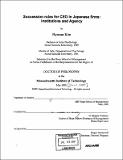| dc.contributor.advisor | D. Eleanor Westney. | en_US |
| dc.contributor.author | Kim, Hyosun, 1967- | en_US |
| dc.contributor.other | Sloan School of Management. | en_US |
| dc.date.accessioned | 2005-06-02T15:31:00Z | |
| dc.date.available | 2005-06-02T15:31:00Z | |
| dc.date.copyright | 2001 | en_US |
| dc.date.issued | 2001 | en_US |
| dc.identifier.uri | http://hdl.handle.net/1721.1/17507 | |
| dc.description | Thesis (Ph.D.)--Massachusetts Institute of Technology, Sloan School of Management, 2001. | en_US |
| dc.description | Includes bibliographical references (leaves 154-160). | en_US |
| dc.description.abstract | The succession of the Chief Executive Officer (CEO) has attracted growing attention from social scientists and management researchers. CEO succession provides a context in which individual decisions and agency, stakeholder interests and conflict, and the organizational needs for legitimacy and acceptance in the large environment come together. Most of these researches, however, have been conducted in the U.S., where the board of directors has the legal and actual responsibility for appointing and replacing the CEO. CEO succession still remains unexplored terrain in countries such as Japan in which the corporation system differs significantly from the U.S. For example, the board of directors in Japan is composed primarily of executives and non-executive members of the firm and overwhelmingly represents the interests of the employees. Also, a Japanese CEO enjoys considerable autonomy from stakeholder influence, where he is usually the sole authority in deciding the timing of his own retirement as well as his successor. Although main banks provide a limit to CEO power, they tend to refrain from intervening in CEO succession until the firm is in a dire condition. In this thesis, I apply the model of CEO succession based on U.S. firms to the study of Japanese CEO succession. I address three questions: 1) what are the rules in the shacho (Japanese equivalent of CEO) succession process; 2) how are the rules framed and what does this linguistic framing suggest about shacho succession in Japan; and 3) how do the rules affect the various succession processes, such as the timing of change as well as the relationship between performance and rules. | en_US |
| dc.description.abstract | (cont.) The theoretical framework I use is based on the institutional theory of action by March (1994) and March & Olsen (1989), and I rely on both qualitative and quantitative methods to answer the research questions. I use a qualitative study to identify succession rules in large Japanese firms. Through CEO succession stories from popular business journals, I identify the two guiding spirits of CEO succession in Japan: the spirit of rejuvenation, in which the CEO succession's main function is to bring younger executives to the leadership position,and the principle of hanamichi (translated as 'flower way'), in which the CEO succession celebrates good performance by the exiting leader. In addition, tenure rules, such as four-year rules, six-year rules, and sometimes ten-year rules, are widely used for guiding the CEO succession process in Japan. | en_US |
| dc.description.abstract | (cont.) I then turn to a large sample longitudinal study to test the implication of one of the succession rules-the tenure rules-identified in the qualitative analysis. I capture thevarious tenure rules by suggesting the concept of tenure milestone set by the predecessor's tenure. A CEO's life cycle can be divided into three distinctive periods based on tenure milestone-before the milestone, milestone, and over-the milestone-presenting different mandates for the incumbent CEO. Specifically, I hypothesize that(1) CEO succession is more likely during the tenure milestone period, (2) the effect of performance is different across the three periods, and (3) organizational and political factors moderate the tenure milestone effect on CEO change. I test the hypotheses in asample of the 200 largest industrial companies in Japan over the period 1955-1995 using event history analysis ... | en_US |
| dc.description.statementofresponsibility | by Hyosun Kim. | en_US |
| dc.format.extent | 160 leaves | en_US |
| dc.format.extent | 7278661 bytes | |
| dc.format.extent | 7278466 bytes | |
| dc.format.mimetype | application/pdf | |
| dc.format.mimetype | application/pdf | |
| dc.language.iso | eng | en_US |
| dc.publisher | Massachusetts Institute of Technology | en_US |
| dc.rights | M.I.T. theses are protected by copyright. They may be viewed from this source for any purpose, but reproduction or distribution in any format is prohibited without written permission. See provided URL for inquiries about permission. | en_US |
| dc.rights.uri | http://dspace.mit.edu/handle/1721.1/7582 | |
| dc.subject | Sloan School of Management. | en_US |
| dc.title | Succession rules for CEO in Japanese firms : institutions and agency | en_US |
| dc.type | Thesis | en_US |
| dc.description.degree | Ph.D. | en_US |
| dc.contributor.department | Sloan School of Management | |
| dc.identifier.oclc | 48852255 | en_US |
